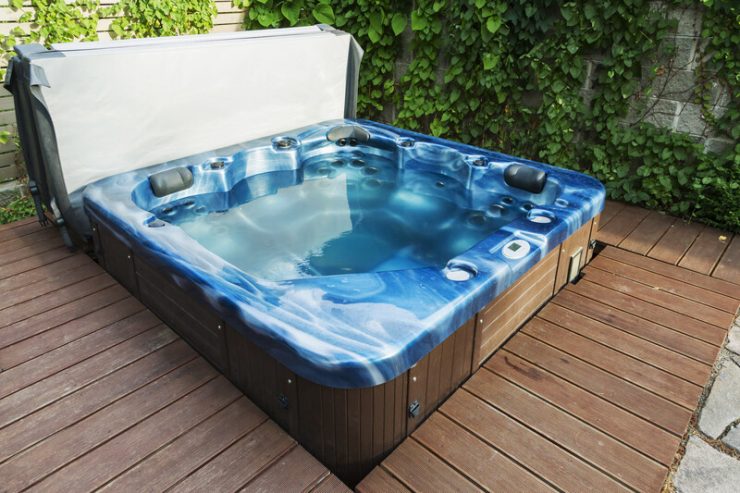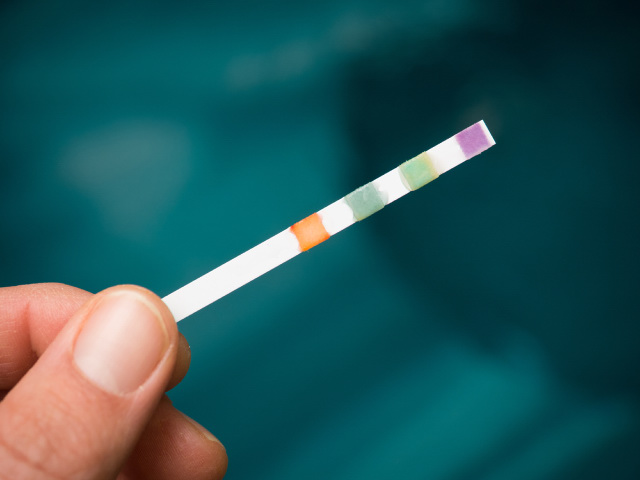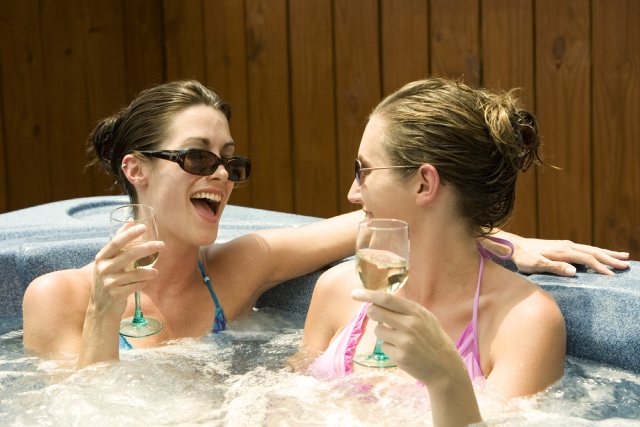You’ve probably shocked a swimming pool before, likely even several times, but never your hot tub. That said, you think your hot tub could probably use it. You’re not sure how to shock a hot tub and if it should be done the same way you shock your pool. How do you do it?
To shock a hot tub, do the following:
- Test the water pH
- Turn off the hot tub jets but leave the pump on
- Apply the shock
- Let the hot tub sit uncovered
- Enjoy a cleaner hot tub
In this guide, we’ll tell you the chemicals you need to shock your hot tub and why you should do it. We’ll also elaborate more on the steps above so you’ll feel confident shocking your hot tub this time and every other subsequent time!

Article Contents
Why Shock Your Hot Tub? The Benefits of Shocking
Do you really have to bother with shocking your hot tub, especially if you already regularly shock your swimming pool? Sure! After all, the hot tub and pool are two totally different things.
Here are some benefits you can enjoy by shocking your hot tub.
No More Bromamines or Chloramines
Most people who don’t sanitize their pool or hot tub with chlorine will use bromine. Its odor is less offensive than chlorine, and it’s gentler on sensitive skin than chlorine.
However, keeping your hot tub clean with bromine will eventually lead to the production of bromamines, a type of waste product.
Just as sanitizing a hot tub with bromine can lead to bromamines, it should come as no surprise that chlorine sanitation can produce chloramines, another type of waste product.
Chloramines, like chlorine itself, smell a heck of a lot stronger than bromamines, and so they’re a lot easier to detect in your hot tub.
By shocking your hot tub, you can say goodbye to bromamines and chloramines and the noxious odors they leave behind.
Rids the Hot Tub of Organic Contaminants
Waterborne organic compounds can include everything from carbon tetrachloride to tetrachloroethylene, trichloroethylene, dichloroethane, xylene, toluene, and benzene. It all depends on who’s using your hot tub and how.
Even if you sanitize your hot tub regularly, the sanitizer probably isn’t doing as excellent of a job removing organic contaminants as you might have thought. Shocking your hot tub will get the job done.
Kills Off Bacteria
Hot tubs are unfortunately hotbeds for diseases spread by bacterial strains.
For example, non-tuberculous mycobacteria can lead to a lung disease where your lungs are chronically irritated and inflamed known as hot tub lung. It can take upwards of a year for the symptoms of hot tub lung to disappear.
The Legionella bacteria causes Legionnaires’ disease with symptoms such as confusion, headache, coughing, shortness of breath, chills and fever, nausea and vomiting, and painful muscles.
You can even develop a hair follicle condition known as hot tub folliculitis from Pseudomonas dermatitis.
When you shock your pool, you kill these bacterial strains before they can make you and your fellow hot tub users seriously ill!
Related Reading: Which is Safer for Your Health: Chlorine or Bromine for a Hot Tub?
The Best Hot Tub Shocks
You can select from so many types of shocks out there, everything from chlorine to non-chlorine, lithium hypochlorite, calcium hypochlorite, biguanide, and dichloroisocyanuric acid aka dichlor.
Here’s the thing though. Based on the type of sanitizer you’re already using in your hot tub (more on this in the next section), you’re really only going to reach for one of three types of shock.
They are chlorine, non-chlorine, and biguanide shocks. Here’s what you need to know about these three types.
Chlorine Shock
Of all the types of shocks, not only the ones we’re talking about, chlorine is undoubtedly the most common.
Chlorine is a very valuable chemical for killing dangerous, disease-causing pathogens and bacteria, preventing the development of algae, and increasing your hot tub’s chlorine levels.
Plus, you know that chlorine can destroy chlorimides, so it’s altogether very useful.
A highly recommended chlorine shock is Spa Time’s dual-purpose sanitizer and shock. Each bottle of shock comes in 14-ounce containers. This product is also an Amazon’s Choice pick.
Non-Chlorine Shock
The next type of hot tub shock is a non-chlorine shock.
It’s not a disinfectant, which means that any bacterial growths in your hot tub will remain even after you use this shock. It would take a powerful chemical such as chlorine to kill off bacteria, as we’ve established by now.
That doesn’t mean that non-chlorine shock is altogether useless, though. Far from it! Potassium peroxymonosulfate is the shock’s active ingredient, and it will oxidize your hot tub.
That means that for cloudy water situations or instances in which you want to remove contaminants from lotion or skin cells, non-chlorine shock is effective. That’s especially true when you apply it at least once per week.
SpaGuard’s spa shock oxidizer comes in 35-fluid-ounce containers and is chlorine-free. It’s also an Amazon’s Choice product!
Biguanide Shock
Finally, there’s biguanide shock, which we’re sure you’re wondering what the heck that even is, right?
Well, in instances where you cannot shock your hot tub with chlorine, you’d use biguanide.
It’s a sanitizer that’s technically known as polyhexamethylene biguanide in full. With its positively charged or cationic polymers, it’s not as effective as chlorine but can still keep your hot tub clean.
SpaGuard Enhanced Shock is a biguanide shock. You can buy a six- or two-pound bottle, which is a great value!
Related Reading: Which Pool Shock Should You Use? (answered!)
Matching Your Hot Tub Shock to Your Sanitizer Type
You can’t just choose from one of the three types of hot tub shocks randomly. Instead, you should make the choice based on the type of sanitizer you already use.
Here’s a handy chart that showcases everything, plus an overview after the jump.
| Type of Hot Tub Sanitizer | Use This Hot Tub Shock |
| Ozonator | Chlorine |
| Ionizer | Chlorine |
| Ultraviolet | Chlorine |
| Saltwater | Chlorine |
| Minerals | Non-chlorine |
| Biguanide | Biguanide |
| Bromine | Chlorine |
| Chlorine | Chlorine and Non-Chlorine |
Ozonator Sanitizer
An Ozonator sits in the middle of your hot tub. Using ultraviolet light, the Ozonator takes oxygen and makes it into ozone. The ozone travels via an air line to the water jet and then enters the hot tub.
For an Ozonator sanitizer, chlorine shock is your best bet.
Ionizer Sanitizer
Ionizers are an alternative to chemical treatments. The ionizer sends positively-charged silver, copper, and zinc into the pool water to maintain water chemistry and keep all parts of your hot tub working optimally.
Chlorine shock is the most compatible with an ionizer.
Saltwater Sanitizer
A salt chlorine generator in your hot tub transforms salty water into chlorine to keep your hot tub clean. Thus, the best type of shock is chlorine. Non-chlorine shock is OK for saltwater systems too but only use this in-between chlorine shocks.
Mineral Sanitizer
A hot tub mineral sanitizer system utilizes copper, silver, and limestone to reduce algae and bacteria in your pool. The sanitizer can absorb chlorine acids to control the pH of your hot tub.
You’re better off with a non-chlorine shock in this case.
Biguanide Sanitizer
We already talked about biguanide in the last section. Here, we just want to make clear that biguanide shock is the only pick for hot tubs that use a biguanide sanitation system.
Bromine Sanitizer
With no bromine shock on our list above, the most compatible type of shock for a bromine sanitizing system is chlorine.
Chlorine Sanitizer
Finally, if your hot tub uses a chlorine sanitizing system, then chlorine is naturally going to be the type of shock you reach for. You can also use non-chlorine shock as a supplement.
Related Reading: What Order Should You Add Chemicals in a New Hot Tub? A Hot Tub Start-Up Guide
How to Shock a Hot Tub
As we said we would, we now want to present the steps per the intro on how to shock a hot tub.
1. Open Your Hot Tub
Do you normally keep your hot tub closed when not in use? A lot of hot tub owners do so debris can’t land in the water.
This is one instance in which you want to open your hot tub wide even if you’re not planning to use it.
2. Test the Water pH
You should have a pH test kit or strips handy to plunk into the water after you open your hot tub. After all, if the pH of the water is lower than it should be or higher, then the shock might not work at its full effectiveness.
You’re looking for a pH reading of 7.4 to 7.6.

3. Turn Off the Hot Tub
Any operating components of the hot tub such as the circulation pump and the jets should not be on. You should also vacate anyone who’s using the hot tub. They’ll have to come back for a swim another day.
4. Apply the Shock
You’ll see usage instructions on the side of the shock bottle or jug. Determine how much shock you need by the number of gallons in the hot tub.
Then transfer only that amount into a measuring cup (make sure it’s chemical-resistant!) and dump the shock into the hot tub.
Since the shock will begin to dissipate or off-gas, and the process can be kind of scary, it’s always best to wear protective equipment when handling shock. You should have goggles, gloves, long sleeves, and pants on. Your feet should be covered as well.
Related Reading: 2 Ways to Raise pH in Hot Tub (pH is Low)
5. Let the Shock Do Its Thing
For at least 20 minutes, give the shock time to work. Step away due to the aforementioned off-gassing. Once the time elapses, you should be safe to cover the hot tub.
How Soon Can You Use Your Hot Tub After Shocking?
Your hot tub is officially shocked. You waited the requisite time, but now you or another family member is itching to take a dip.
Is it safe to use the hot tub the same day you shock it? Before you let someone jump in and become a human guinea pig, test the pH of the hot tub water and the sanitizer levels.
If the pH and sanitizer levels are within range, then it should be safe to enter the water again.

Related Reading: How Long After Shocking a Pool Is It Safe to Swim?
Hot Tub Shocking Safety Tips
To wrap up, here is a collection of our top tips for staying safe when shocking your hot tub.
Keep Chemicals Away from the Hot Tub
Hot tubs are sources of both moisture and heat, which are two primary enemies of shock and other hot tub chemicals.
You should store your chemicals far from the hot tub. Maybe put them in a storage shed on the other side of the lawn.
Always Wash Your Hands After Handling Shock
Even though you were wearing gloves when you poured in the shock, you never know if you could have chemical residue on your hands.
Take two minutes to wash your hands thoroughly with soap and water before you resume your normal activities.
Apply Powder Products on a Still Day
If you’re using a powdered hot tub shock or any other powdered hot tub product, be aware of what the wind can do.
On a blustery day, the chemical can easily be carried away, dispersing onto your lawn.
There, it can kill any grasses, flowers, or plants. Local wildlife could ingest the chemicals and die.
If anyone is in the vicinity when the powder chemicals are blown by the wind, they could end up with a bunch of powder to the face. Since these are dangerous chemicals we’re talking about here, you don’t want them anywhere near your eyes, nose, and mouth.
Don’t Combine Hot Tub Chemicals
Although you might assume that twice the hot tub chemicals would lead to twice the pool clarity, that’s never the case. You only need one type of hot tub shock at a time. Using two types together could create dangerous and unpredictable chemical reactions.
This also goes for your measuring vessel. Use a dedicated vessel for EACH type of chemical. Even small traces of chemicals that were previously in the container could react when you pour in new chemicals.
Related Reading:
How to Raise Pool pH Without Raising Alkalinity (TA)
How Long Does It Take to Heat a Hot Tub? (and Tips for Faster Heating)
Can You Fill a Hot Tub or Spa with Well Water?
How to Raise Alkalinity in Hot Tub (Alkalinity is Low)
Soda Ash vs. Baking Soda for Hot Tub: Which is Better?
Chlorine Vs Bromine for Hot Tubs (Which is Better?)
Can You Use Clorox or Bleach in a Hot Tub?




